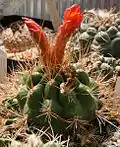| Matucana aurantiaca | |
|---|---|
 | |
| Scientific classification | |
| Kingdom: | Plantae |
| Clade: | Tracheophytes |
| Clade: | Angiosperms |
| Clade: | Eudicots |
| Order: | Caryophyllales |
| Family: | Cactaceae |
| Subfamily: | Cactoideae |
| Genus: | Matucana |
| Species: | M. aurantiaca |
| Binomial name | |
| Matucana aurantiaca (Vaupel) Buxb. | |
| Synonyms | |
| |
Matucana aurantiaca (common name, orange matucana[2]) is a species of flowering plant in the cactus family Cactaceae. It grows in the Cajamarca and La Libertad regions of Peru.[3] It is considered to have a stable population and a wide range with no threats.[1]
Description
Matucana aurantiaca grows in clusters of ribbed or solitary and rarely branches from the base, spiny spheres or cylinders reaching about 15–35 cm (5.9–13.8 in) (rarely up to 50 centimeters) in height with a diameter of 15 centimeters. The spherical to broadly cylindrical, green to dark green shoots reach heights of growth of up to There are 13 to 19 broad ribs made up of hexagonal protuberances. The distinct, straight, yellowish brown spines turn gray with age. The approximately nine central spines are 2 to 7 centimeters long. The twelve to 20 radial spines have a length of 0.5 to 4 centimeters. It bears orange funnel-shaped flowers in summer.[2] The Latin specific epithet aurantiaca means "orange".[4] The orange-red to red flowers are 7 to 9 centimeters long and reach a diameter of 5 to 7 centimeters. Your bracts are edged purple, the flower mouth is slightly crooked to straight. The diameter of the spherical green fruits is up to 2 centimeters.
Subspecies
| Image | Subspecies | Description | Distribution |
|---|---|---|---|
 | Matucana aurantiaca subsp. aurantiaca | Cajamarca and La Libertad, Peru. | |
| Matucana aurantiaca subsp. currundayensis (F.Ritter) Mottram | La Libertad, Peru. | ||
 | Matucana aurantiaca subsp. fruticosa (F.Ritter) Mottram | Cajamarca, Peru. | |
| Matucana aurantiaca subsp. hastifera (F.Ritter) Mottram | Peru. | ||
 | Matucana aurantiaca subsp. polzii (Diers, Donald & Zecher) Mottram | Huánuco, Peru. | |
Distribution
Matucana aurantiaca is distributed in the Peruvian regions of Ancash, La Libertad, Cajamarca and possibly Piura at altitudes of 2000 to 3700 meters.
Taxonomy
The plant was first described as Echinocactus aurantiacus was in 1913 by Friedrich Karl Johann Vaupel.[5] Franz Buxbaum placed the species in the genus Matucana in 1973. Other nomenclature synonyms are Arequipa aurantiaca (Vaupel) Werderm. (1939), Borzicactus aurantiacus (Vaupel) Kimnach & Hutchison (1957) and Submatucana aurantiaca (Vaupel) Backeb. (1959).
Cultivation
In temperate areas this plant requires some protection from rain and frost, so is best grown under glass in an unheated greenhouse which receives plenty of sun. It is kept dry through the winter, but watered and fed during the growing season, from spring to autumn. In cultivation in the United Kingdom it has been given the Royal Horticultural Society's Award of Garden Merit.[2][6]
References
- 1 2 Ostalaza, C.; Roque, J. (2017). "Matucana aurantiaca". IUCN Red List of Threatened Species. 2017: e.T152606A121542104. doi:10.2305/IUCN.UK.2017-3.RLTS.T152606A121542104.en. Retrieved 12 November 2021.
- 1 2 3 "Matucana aurantiaca". Royal Horticultural Society. Retrieved 22 June 2015.
- ↑ "Matucana aurantiaca". Cacti Guide. Retrieved 22 June 2015.
- ↑ Harrison, Lorraine (2012). RHS Latin for Gardeners. United Kingdom: Mitchell Beazley. ISBN 978-1845337315.
- ↑ Engler, Adolf (1914). "Botanische Jahrbücher fur Systematik, Pflanzengeschichte und Pflanzengeographie". Schweizerbart [etc.] ISSN 0006-8152. Retrieved 2023-08-23.
- ↑ "AGM Plants - Ornamental" (PDF). Royal Horticultural Society. July 2017. p. 64. Retrieved 4 April 2018.
External links
 Media related to Matucana aurantiaca at Wikimedia Commons
Media related to Matucana aurantiaca at Wikimedia Commons Data related to Matucana aurantiaca at Wikispecies
Data related to Matucana aurantiaca at Wikispecies
